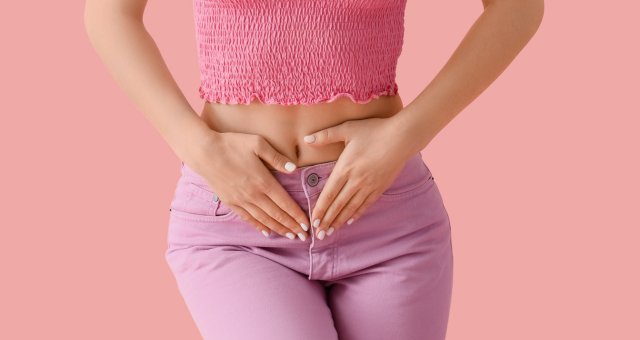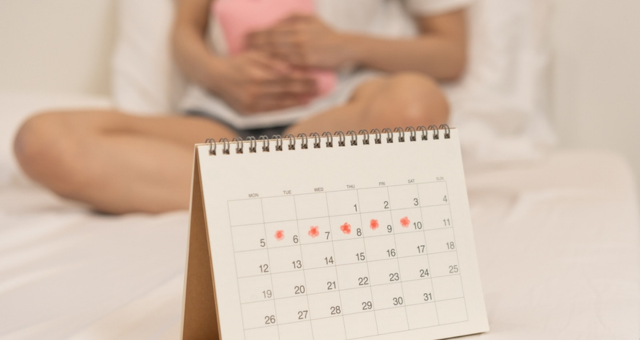Medically Reviewed by Lucas Rosa, PhD in Molecular Biology
Every month, your body goes through a complex, beautifully coordinated process called the menstrual cycle. Though it’s often reduced to “that time of the month,” your cycle actually involves several weeks of shifting hormones, each with unique effects on your energy, mood, skin, appetite, and more.
Understanding your menstrual cycle is like having a personal health blueprint. When you know what’s happening hormonally in each phase, you can better care for your body, make sense of your symptoms, and even optimize your workouts, meals, and rest.
This article breaks down the four phases of the cycle, the hormones involved, common symptoms, and natural ways to help the cycle run smoothly.
What Is the Menstrual Cycle?
The menstrual cycle is a monthly sequence of hormonal changes that prepare the body for a possible pregnancy. It typically lasts between 25 to 35 days, with 28 days being the average. During this cycle, the body moves through four main phases:
- Menstrual phase
- Follicular phase
- Ovulation
- Luteal phase
Each phase is driven by rising and falling levels of key hormones like estrogen, progesterone, luteinizing hormone (LH), and follicle-stimulating hormone (FSH). These hormones don’t just affect your reproductive system – they influence your brain, digestion, metabolism, and emotional well-being.

Phase 1: The Menstrual Phase (Days 1–5)
This phase begins when your period starts. It’s the body’s way of shedding the uterine lining if no pregnancy occurred the previous cycle.
- Hormones: Both estrogen and progesterone are at their lowest during this time, which is why you might feel tired, heavy, or emotionally sensitive.
- What’s happening: The uterus contracts to release the endometrial lining, which causes cramping in some women.
- Common symptoms: Bleeding, fatigue, irritability, bloating, and headaches.
- Natural support: Prioritize rest, eat iron-rich foods like leafy greens and lentils, stay hydrated, and apply heat packs to ease cramps. Gentle movement like stretching or walking can also help.
Phase 2: The Follicular Phase (Days 1–13)
This phase overlaps with menstruation at the start but continues beyond it. It’s when your body prepares an egg for release.
- Hormones: Estrogen and FSH (follicle-stimulating hormone) begin to rise, which boosts energy and improves mood.
- What’s happening: FSH stimulates the ovaries to grow follicles, one of which will become the dominant egg.
- Common symptoms: Increased focus, higher libido, motivation, and clearer skin.
- Natural support: This is a great time for strength training, goal setting, and eating protein-rich meals to support follicle growth. Include healthy fats like avocado and olive oil to help build hormones.
Phase 3: Ovulation (Around Day 14)
Ovulation is the main event of the cycle – when the mature egg is released from the ovary and can potentially be fertilized.
- Hormones: LH (luteinizing hormone) surges, triggering ovulation. Estrogen peaks, and testosterone rises briefly, enhancing confidence and sex drive.
- What’s happening: The egg travels down the fallopian tube toward the uterus.
- Common symptoms: Heightened sense of smell, increased cervical mucus (egg-white texture), a mild twinge in the lower abdomen, and boosted energy.
- Natural support: Stay hydrated, nourish your body with antioxidants (think berries, leafy greens), and consider gentle workouts or social time to match your high-energy mood.
Phase 4: The Luteal Phase (Days 15–28)
If the egg isn’t fertilized, your body shifts into the luteal phase. This is when progesterone takes center stage.
- Hormones: Progesterone rises to thicken the uterine lining in case of pregnancy. Estrogen dips slightly, then may rise again before both hormones fall near the end.
- What’s happening: Your body either prepares to support a pregnancy or get ready for menstruation.
- Common symptoms: Mood swings, fatigue, breast tenderness, cravings, bloating, and sleep disruptions (especially if progesterone is low).
- Natural support: Focus on warm, comforting meals like stews or roasted vegetables. Magnesium-rich foods like dark chocolate and nuts can ease PMS symptoms. Try slower forms of exercise like yoga or walking, and support liver function with cruciferous vegetables like broccoli and cauliflower to help clear excess estrogen.
How Hormones Influence Each Phase of the Cycle
Your menstrual cycle is guided by the rise and fall of four main hormones – estrogen, progesterone, luteinizing hormone (LH), and follicle-stimulating hormone (FSH). These hormones don’t just affect your reproductive organs; they also impact how you feel emotionally, how much energy you have, how you sleep, and even what kinds of foods you crave.
- Estrogen Rise: In the early part of your cycle, estrogen gradually increases, especially during the follicular phase. This rise can bring a lift in mood, sharper thinking, and more stable energy levels. Many women feel more outgoing, confident, and productive during this time, partly thanks to estrogen’s effects on the brain.
- LH Surge: Around ovulation, LH spikes and estrogen peaks, often bringing a sense of vitality and higher libido. You might feel more physically capable, more socially engaged, and more mentally clear. Testosterone also rises slightly around this time, which can boost motivation and confidence.
- Progesterone Rise: Once you enter the luteal phase, progesterone starts to rise. This hormone has a calming, stabilizing effect on the nervous system. It helps prepare the uterine lining for a possible pregnancy and supports sleep and relaxation. However, if progesterone is too low – or if estrogen remains high in comparison – it can lead to symptoms like irritability, breast tenderness, bloating, or anxiety.
- Estrogen and Progesterone Drop: Just before your period, both estrogen and progesterone levels drop significantly. This hormonal withdrawal is what often triggers PMS symptoms, including mood swings, cravings, fatigue, and disrupted sleep. Once menstruation begins, hormone levels hit their lowest point, which is why many people feel drained or low-energy during the first couple of days of their period.
These hormonal shifts are normal, but when the changes feel extreme or unmanageable, it’s often a sign that your cycle needs extra support. Tuning into how your hormones affect your body at each stage can help you care for yourself more intentionally and make lifestyle choices that ease the transition between phases.
Signs Your Cycle May Be Off Track
Not all menstrual cycles run like clockwork. If you’re experiencing irregularities, it could be a sign that your hormones are imbalanced. Common signs include:
- Irregular or missed periods
- Painful or heavy bleeding
- Severe mood swings or anxiety before your period
- Acne, especially around the chin or jaw
- Spotting between periods
- Difficulty sleeping or extreme fatigue in the luteal phase
These symptoms may point to underlying issues such as estrogen dominance, low progesterone, thyroid imbalances, or conditions like PCOS. A healthcare provider or hormone-savvy practitioner can help you get to the root.

Natural Ways to Help the Menstrual Cycle Run Smoothly
Supporting your cycle naturally doesn’t mean doing everything perfectly – it means understanding your body’s rhythm and giving it what it needs during each phase.
Working with your cycle, rather than against it, can help smooth out hormonal shifts and ease common symptoms like mood swings, fatigue, and cravings. These daily habits can make a real difference in how you feel throughout each phase.
Eat with your cycle
Your nutritional needs change with your hormones. During your period, focus on iron-rich foods like spinach, lentils, and red meat to replenish what you lose through bleeding. In the follicular phase, support rising estrogen with lean proteins, leafy greens, and fermented foods. Around ovulation, boost antioxidant intake with colorful fruits and vegetables. During the luteal phase, magnesium-rich foods like dark chocolate, pumpkin seeds, and bananas can help ease PMS and support relaxation. (1)
Reduce stress
Chronic stress can throw off your entire hormonal rhythm, delaying ovulation or shortening your luteal phase. Daily stress management techniques like meditation, yoga, journaling, breathwork, or simply stepping outside for a few minutes can help balance cortisol levels and allow reproductive hormones to do their job without interruption. (2)
Avoid endocrine disruptors
Certain chemicals found in plastics, skincare products, and non-organic foods can mimic or block natural hormones, leading to imbalance over time. (3)
Try switching to glass containers, using fragrance-free or natural personal care items, and eating organic produce when possible – especially for foods on the Dirty Dozen list by the EGC group.
Support liver detox
Your liver plays a key role in breaking down and clearing excess hormones, especially estrogen. Eating cruciferous vegetables like broccoli, kale, and Brussels sprouts helps your liver process hormones more efficiently. Drinking plenty of water and limiting alcohol can also support healthy detoxification pathways. (4)
Move mindfully
Exercise is great for hormone health, but syncing your movement to your cycle can make it even more effective. Do higher-intensity workouts like cardio or strength training during the follicular and ovulatory phases when energy is higher. In the luteal and menstrual phases, switch to gentler activities like walking, stretching, or restorative yoga to support recovery and hormonal balance. (5)
Track your cycle
Using a period-tracking app or journal to monitor symptoms, emotions, energy levels, and period dates helps you understand your unique hormonal rhythm. Over time, you’ll start to notice patterns – like when you feel your best, when you need rest, or when certain symptoms show up. This self-awareness allows you to make proactive choices and catch imbalances early. (6)
These small, intentional changes can add up to a big improvement in how you experience your cycle, making each phase more manageable and even empowering.

Take Away
Your menstrual cycle isn’t just about reproduction – it’s a direct reflection of your hormone health, stress levels, diet, sleep, and overall well being. By understanding the different phases of your cycle and how hormones guide them, you can start to work with your body rather than against it.
Whether you’re aiming for better energy, clearer skin, easier periods, or hormonal balance, supporting your cycle with daily habits makes a big difference. Listen to your body, respond to its signals, and remember – your cycle is one of the most powerful tools you have for understanding your health.
References
- Rogan MM, Black KE. Dietary energy intake across the menstrual cycle: a narrative review. Nutr Rev. 2023 Jun 9;81(7):869-886. doi: 10.1093/nutrit/nuac094. PMID: 36367830; PMCID: PMC10251302.
- Chhikara A, Jain M, Vats S, Kashoo FZ, Chahal A, Guliya S, Vajrala KR, Sidiq M, Rai RH. Role of Yoga in Minimizing Stress and Anxiety in Women Experiencing Dysmenorrhea. J Lifestyle Med. 2023 Aug 31;13(2):90-96. doi: 10.15280/jlm.2023.13.2.90. PMID: 37970322; PMCID: PMC10630717.
- Park J, Lee JJ, Park S, Lee H, Nam S, Lee S, Lee H. Endocrine Disrupting Chemicals and Premenstrual Syndrome in Female College Students in East Asia: A Multi-Country Study. Int J Womens Health. 2022 Feb 9;14:167-177. doi: 10.2147/IJWH.S349172. PMID: 35173491; PMCID: PMC8842637.
- Draper CF, Duisters K, Weger B, Chakrabarti A, Harms AC, Brennan L, Hankemeier T, Goulet L, Konz T, Martin FP, Moco S, van der Greef J. Menstrual cycle rhythmicity: metabolic patterns in healthy women. Sci Rep. 2018 Oct 1;8(1):14568. doi: 10.1038/s41598-018-32647-0. Erratum in: Sci Rep. 2019 Apr 3;9(1):5797. doi: 10.1038/s41598-019-41392-x. PMID: 30275458; PMCID: PMC6167362.
- Daley A. The role of exercise in the treatment of menstrual disorders: the evidence. Br J Gen Pract. 2009 Apr;59(561):241-2. doi: 10.3399/bjgp09X420301. PMID: 19341553; PMCID: PMC2662100.
- Schantz JS, Fernandez CSP, Anne Marie ZJ. Menstrual Cycle Tracking Applications and the Potential for Epidemiological Research: A Comprehensive Review of the Literature. Curr Epidemiol Rep. 2021 Mar;8(1):9-19. doi: 10.1007/s40471-020-00260-3. Epub 2021 Feb 20. PMID: 34055569; PMCID: PMC8162175.
Check Out
HF Swaps
Better products for better hormone health.









